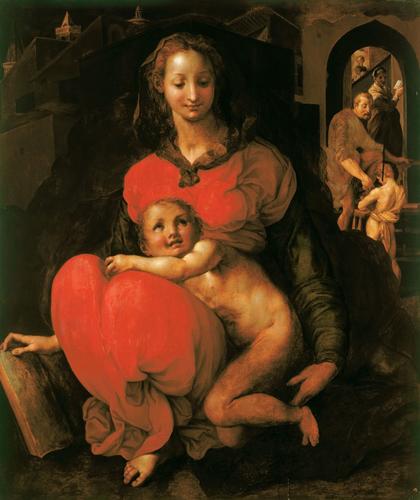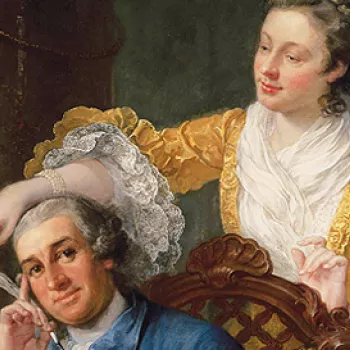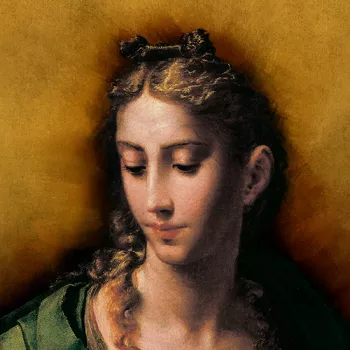The Virgin and Child c.1534-40
Oil on panel | 122.0 x 102.2 cm (support, canvas/panel/stretcher external) | RCIN 406117
-
The Virgin is seated on the ground, like a Madonna of Humility; she holds a book open with one hand while the Christ Child looks up ecstatically, perhaps from contemplation of the words on a folded piece of paper, now transparent, in his left hand. In the background Joseph holds his saw in one hand while reaching to take some cherries (the fruit of paradise and symbolising Heaven) from a container held by a young boy, possibly St John the Baptist or an older manifestation of the Christ Child, helping his father. The older woman with a book could therefore be St Elizabeth, John’s mother, or St Anne, the Virgin’s mother. It is likely that it is a servant girl on the stairs silhouetted against a cloudy sky. The three buildings in the background may be part of Pontormo’s neighbourhood in Florence; the church spire on the left could have been that of the now destroyed S. Piero Maggiore.
This painting of the Virgin and Child, often referred to as the Madonna with the Book, is one of at least twenty-five versions of the subject, making it the most successful painting by Pontormo and the most copied work of the period in Florence. The technique here with its lucid definition of form suggests that this one is by Pontormo himself. There is little agreement about the date of this composition, partly because so few comparable works of Pontormo survive from the 1530s and 1540s. It is likely that Vasari refers to this composition, given his thoroughness and its popularity, in which case it must be one of the three paintings of the Virgin mentioned in his life of Pontormo. By far the most likely candidate is the first, ‘a most beautiful painting of our Lady’, with which the artist paid his stonemason, Rossino, for building work on his house. Other circumstances connected with this building work mentioned in Vasari’s text suggest that it must have taken place in the early to mid-1530s, although no documents exist to confirm this. The painting was later acquired by Ottaviano de’ Medici and was in the collection of his son, Alessandro, by 1568, where it remained until his death in 1605; these collections were accessible to artists, which would explain why the composition became so well known.
It has been suggested that the prominent unfinished building, the depiction of Joseph as a carpenter and the humble pose of the Madonna are all references to the manual trade of the recipient of this painting. It has also been proposed that the themes were unusual at this date but would have appealed later to the promoters of the Counter Reformation, which would account for the popularity of the composition.
The seated Virgin and the turn of Christ’s head above his bare arm recall Michelangelo’s Doni Tondo of c.1504-6 (Uffizi. Florence), as does the nearly nude figure of St John the Baptist in the background. Christ looking back over his shoulder recalls Michelangelo’s Taddei Tondo of the same date (Royal Academy of Arts, London). The smiling face of the Virgin and the turn of her legs to the left can be found in the figure of St Anne in Leonardo da Vinci’s Virgin and Child and St Anne of c. 1508-18 (Louvre, Paris). Leonardo may have begun this in Florence where Pontormo would have seen it, particularly if, as Vasari states, he was apprentice to Leonardo at this time.
No version of this painting has been unanimously accepted as the original, though various candidates have been proposed. This version has as good a claim as any, although it has elements, like the blank page of the book and the ogee-shape of the arch, which are only followed in one other copy. The technique suggests that this is an autograph work (and not a copy) and is very suggestive of Pontormo’s hand.
Catalogue entry adapted from The Art of Italy in the Royal Collection: Renaissance and Baroque, London, 2007Provenance
Probably acquired either by Frederick, Prince of Wales, or George III; first recorded in Queen Caroline's Bedroom at Kensington Palace in 1818 (no 439)
-
Creator(s)
Previously attributed to (artist)Previously attributed to (artist)(nationality) -
Medium and techniques
Oil on panel
Measurements
122.0 x 102.2 cm (support, canvas/panel/stretcher external)
135.0 x 115.7 x 7.3 cm (frame, external)











